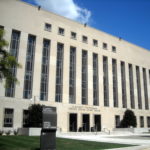Articles Category
The Rise and Fall of Plausibility Pleading?
Mar. 21, 2016—Rise and Fall of Plausability Pleading? ABSTRACT The Supreme Court’s 2007 decision in Bell Atlantic Corp. v. Twombly and its 2009 decision in Ashcroft v. Iqbal unleashed a torrent of scholarly reaction. Commentators charged these decisions with adopting a new pleading regime, “plausibility pleading,” that upended the notice-pleading approach that had long prevailed in federal...
Regulation of Emerging Risks
Mar. 21, 2016—Regulation of Emerging Risks ABSTRACT Why has the EPA not regulated fracking? Why has the FDA not regulated e-cigarettes? Why has NHTSA not regulated autonomous vehicles? This Article argues that administrative agencies predictably fail to regulate emerging risks when the political environment for regulation is favorable. The cause is a combination of administrative law and interest group politics. Agencies must...
The Management of Staff by Federal Court of Appeals Judges
Mar. 21, 2016—The Management of Staff by Federal Court of Appeals Judges ABSTRACT Federal court of appeals judges have staffs consisting usually of a secretary and four law clerks; some judges have externs as well (law students working part time without pay). These staffs are essential, given judicial workloads and judges’ limitations. Yet not much is known about how the...
The Commensurability Myth in Antitrust
Jan. 15, 2016—The Commensurability Myth in Antitrust ABSTRACT Modern antitrust law pursues a seemingly unitary goal: competition. In fact, competition—whether defined as a process or as a set of outcomes associated with competitive markets—is multifaceted. What are offered in antitrust cases as procompetitive and anticompetitive effects are typically qualitatively different, and trading them off is as much...
Incarceration Incentives in the Decarceration Era
Jan. 15, 2016—Incarceration Incentives in the Decarceration Era ABSTRACT After forty years of skyrocketing incarceration rates, there are signs that a new “decarceration era” may be dawning; the prison population has leveled off and even slightly declined. Yet, while each branch of government has taken steps to reduce the prison population, the preceding decades of mass incarceration...
The Regulatory Contract in the Marketplace
Jan. 15, 2016—The Regulatory Contract in the Marketplace ABSTRACT For decades, energy policy has struggled to reconcile two distinct visions for the future: the first seeks ever-more-competitive, efficient, and dynamic electricity markets, while the second seeks an ever-greener mix of electricity generation sources. Caught within this push-and-pull dynamic is the regulatory contract—a nineteenth-century concept that stands more...
High Value Lies, Ugly Truths, and the First Amendment
Nov. 23, 2015—High Value Lies, Ugly Truths, and the First Amendment AUTHORS Alan K. Chen William M. Beaney Memorial Research Chair and Professor of Law, University of Denver Sturm College of Law. Justin Marceau Animal Legal Defense Fund Professor of Law, University of Denver Sturm College of Law. The authors would like to thank Ashutosh Bhagwat, Richard...
An Executive-Power Non-Delegation Doctrine for the Private Administration of Federal Law
Nov. 23, 2015—An Executive-Power Non-Delegation Doctrine for the Private Administration of Federal Law ABSTRACT Private entities often administer federal law. The early-twentieth-century Supreme Court derived constitutional limits to delegations of administrative power to private entities, grounding them in Article I of the Constitution where legislative power is delegated and in the Due Process Clause where the delegee’s...
How Algorithmic Trading Undermines Efficiency in Capital Markets
Nov. 23, 2015—How Algorithmic Trading Undermines Efficiency in Capital Markets ABSTRACT This Article argues that the rise of algorithmic trading undermines efficient capital allocation in securities markets. It is a bedrock assumption in theory that securities prices reveal how effectively public companies utilize capital. This conventional wisdom rests on the straightforward premise that prices reflect available information...
Curb Your Enthusiasm for Pigovian Taxes
Nov. 23, 2015—Curb Your Enthusiasm for Pigovian Taxes ABSTRACT Pigovian (or “corrective”) taxes have been proposed or enacted on dozens of harmful products and activities: carbon, gasoline, fat, sugar, guns, cigarettes, alcohol, traffic, zoning, executive pay, and financial transactions, among others. Academics of all political stripes are mystified by the public’s inability to see the merits of...
In Praise of Ex Ante Regulation
Nov. 23, 2015—In Praise of Ex Ante Regulation ABSTRACT Timing is an important consideration in regulatory design. Corrective taxes are usually imposed before or contemporaneously with the harmful activity they are aimed at preventing, while tort awards are assessed ex post, in its aftermath. Patents and research grants both can encourage innovation, but patents pay off only...
Overcriminalization’s New Harm Paradigm
Oct. 14, 2015—Overcriminalization’s New Harm Paradigm ABSTRACT The harms of overcriminalization are usually thought of in a particular way—that the proliferation of criminal laws leads to increasing and inconsistent criminal enforcement and adjudication. For example, an offender commits an unethical or illegal act and, because of the overwhelming depth and breadth of the criminal law, becomes subject...
Second Liens and the Leverage Option
Oct. 14, 2015—Second Liens and the Leverage Option ABSTRACT This Article demonstrates that the housing bubble was driven by second mortgages to a much greater extent than previously appreciated. A unique feature of American law allows homeowners to take out second mortgages, without the consent or even knowledge of the first mortgage lender. The result is an...
Regulatory Exit
Oct. 14, 2015—Regulatory Exit ABSTRACT Exit is a ubiquitous feature of life, whether breaking up in a marriage, dropping a college course, or pulling out of a venture capital investment. In fact, our exit options often determine whether and how we enter in the first place. While legal scholarship is replete with studies of exit strategies for...
The Supreme Court and the New Equity
May. 15, 2015—The Supreme Court and the New Equity ABSTRACT The line between law and equity has largely faded away. Even in remedies, where the line persists, the conventional scholarly wisdom favors erasing it. Yet something surprising has happened. In a series of cases over the last decade and a half, the U.S. Supreme Court has acted...
Misdemeanor Decriminalization
May. 15, 2015—Misdemeanor Decriminalization ABSTRACT As the United States reconsiders its stance on mass incarceration, misdemeanor decriminalization has emerged as an increasingly popular reform. Seen as a potential cure for crowded jails and an overburdened defense bar, many states are eliminating jailtime for minor offenses such as marijuana possession and driving violations, replacing those crimes with so-called...



